 |
 |
News |
|
 |
| |
|
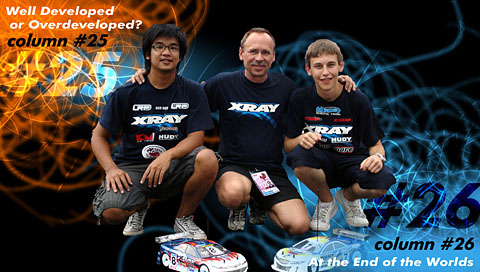
(click to enlarge) |
|
| Column #25 - Well Developed or Overdeveloped? |
|
| Readers of my column and XRAY customers know that we have started the XRAY brand back in 2000 with the introduction of the T1, our first electric touring car. I remember those times very well with passion and nostalgia. At those times, electric touring cars were just settling in the RC car scene and nobody knew how or where the development of the category would move. In those pioneer days most companies were having different ideas and points of view of how the design of a touring car should be, and those touring cars were also greatly diverse and different. Of course something that is different is usually somewhere between bad and great. As such we would see some types of touring cars working perfectly on asphalt but not so well on the carpet, or conversely we would see a touring car platform that was unbeatable on rubber tires but struggled on foam tires. You get the picture Iâ™m sure. Those were the days when RC car designers were still learning and gaining the experience and of course for me, my racing team and R&D team were in the same situation. |
|
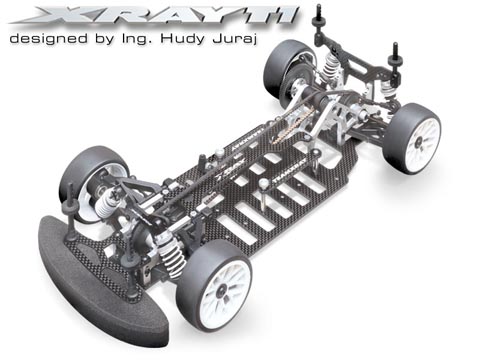
(click to enlarge) |
|
|
|
| I am sure that those customers who were with XRAY from the very first days remember the pivotball suspension on the first T1, then with fast development over the next few years came the change to C-hub suspension. I am sure that all those electric touring car racers also remember the big battles those days â“ not so much on the track but more in Internet chat forums â“ about the performance differences between shaft-drive vs. belt-drive, where supporters of one drivetrain were claiming to be a few seconds faster than the other. Of course, those heated discussions expanded to include single-belt drivetrainsâ™ out-performance of dual-belt or shaft-driven drivetrains. To say it was âśentertainingâť would be an understatement. |
|
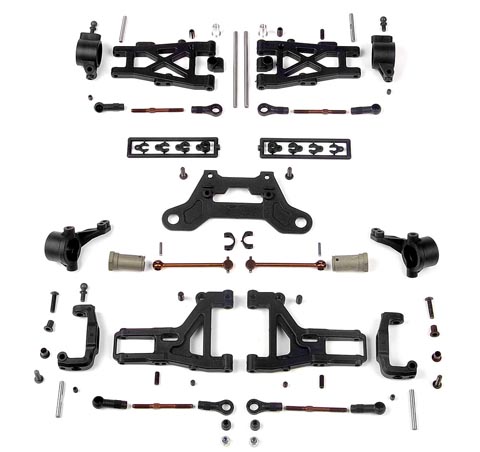
(click to enlarge) |
|
|
|
| All of these controversies were usually from super-enthusiastic supporters of the electric touring car development. All the teams were battling each other with all their different platforms, ideas and concepts⦠and still we all were learning and gaining a lot of experience. A few times we made wrong decisions but many times we came up with new & innovative design ideas which improved lap times and car performance, and made the customers more satisfied. Some people would call this âśKanzen,âť a Japanese expression for a process of continuous development and improvement to achieve excellence. Excellence is what drives my passion and dedication to further develop and improve our cars and products. |
|
|
| Our racing and R&D teams have worked very hard and diligently over the last 8 years to make our electric touring car easier to drive, lighter, and more effective⦠or simply put: better and faster. Sure we have made some less-than-perfect decisions (like everyone else), but those bad experiences turn into learning experiences to motivate and drive development to make things better. In the background we are always testing and working on new ideas, developments, and concepts; we annually spend thousands upon thousands of hours behind the computer and in production working on new prototypes, and on the tracks around the world testing the new stuff and new parts to gain a better understanding of what we can do better to get better overall performance. At the end, all the data / information / feedback / test results / reports / comments / ideas gathered during one year are sifted through and at the end the best of the best was blended into a new touring car. Our attitude has always been different from most other companies; all the products & components that are team tested and found to be positive during the year was at the end transformed into a product which became commercially available for any customer. As such, regular customers could use those same parts that our factory team drivers used to dominate races worldwide. |
|
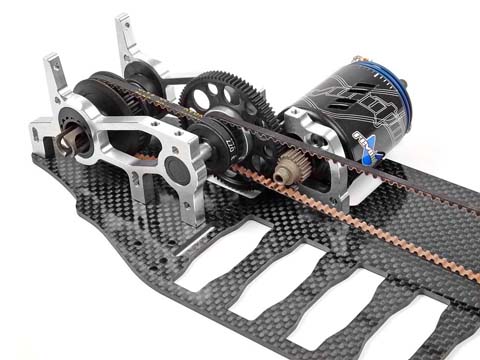
(click to enlarge) |
|
|
|
| Over the last few years, development of touring cars has been at a frantic pace. The huge amount of the hours spent testing and working on new ideas always makes the car better, but in many cases even though our confidence and results were positive we faced a lot of political and marketing difficulties. In the early days many customers could not live without shaft-driven drivetrain cars, and then the same thing happened with single-belt drivetrain cars. Pressure from customers, shops, and distributors was really huge. However, I was still convinced â“ and our testing results confirmed my belief â“ that the dual-belt drivetrain was the best concept and platform for the electric touring car. At some point we were one of the few who bucked the âśtrendsâť and marketing hype and knowing that we might (temporarily) lose customers. At the end my steadfastness paid off, confirming my belief that you always need to trust in yourself and be strong even if you are alone in your beliefs. |
|
|
| If you look at all the electric touring cars on the market nowadays, you will see that all of them are dual-belt drivetrains, that all of them have the same general layout & concept, and that all of them look remarkably similar at first glance. Is it bad? I do not know. Is it good? I do not know that neither. I just know that over the last few years the touring car design developed so fast that many companies could not handle the pressure and keep up with the super fast development, thus retiring from this class. Development was so fast that once we released a new car, we were already working and testing the next car and concept already. All of this super-fast development has brought touring car design to the pinnacle of perfection and maturity. This is typical for most sports and in the RC model hobby it applies to all categories and whether it be 1/8 on-road, 1/8 off-road, 1/12 pan car or any other scale, most high-competition cars look the same. Of course it took years, decades and sometimes even longer until the cars reached this stage of maturity, struggling through the âświld yearsâť of different (and many times âśstrangeâť) concepts and ideas. |
|
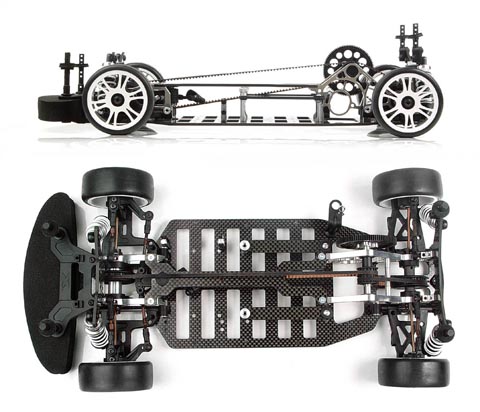
(click to enlarge) |
|
|
|
| Even though cars look the same, itâ™s the details that make the big differences; I can assure you that what is behind the look is most important. Materials, composite structures, and many other things you cannot see by your eyes are those things that make the difference in handling, performance, and reliability of the car. Nowadays when I am asked the typical question about what I think if touring cars can be further improved, I always say that itâ™s in the nature of human beings to make things better. I believe that development can still go further, especially in terms of materials. I am convinced that we will not see any wild or dramatic developments like those that occurred over the last decade, but then again one should never say never. These days we are witnesses to the motor and battery revolution, with brushless motors replacing the once standard brushed motors and we expect that LiPo batteries will overtake the once-standard sub-C battery market completely. This will force RC car designers to go back to drawing boards to think about and come up with new ideas, concepts and parts that will make touring cars again more optimized for the new trends. |
|
|
| Therefore until we see demand and interest in the electric touring cars and racing wane, we can be sure that development will never stop. Is it good or bad? I donâ™t know about others, but for me it is great proof that we can all still make things better. Over the last few years we have seen all of our ideas and concepts evolve into new electric touring cars which were designed, produced and delivered to regular racers year after year. I know that there are people who are frustrated with XRAY releasing a new electric touring car every year, but the majority of our customers choose XRAY for this very reason⦠knowing that we continue with development and make things better. Of course we could keep the new and improved ideas and parts for our team only, but that is not what my philosophy is. |
|
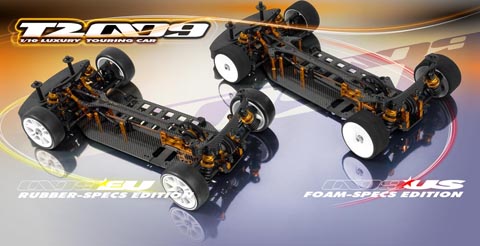
(click to enlarge) |
|
|
|
| During this year we have worked very hard on the processor of the T2â™008, but for the first time we were faced with the situation where we could not bring anything fundamentally new or different for 2009. The fact is that the T2â™008 has been such a great performing car that there is nothing major we could improve upon. But the second and main fact is that with electronics development in a âśdevelopment explosionâť these days with no set rules, we could ill afford to focus and change something (for example, optimizing the platform for LiPo) when the rules might change the next day. At this time we are all blind to what the future will bring, but we know with confidence that once the rules start to fall into place, XRAY will be at the forefront of developing towards those future trends. |
|
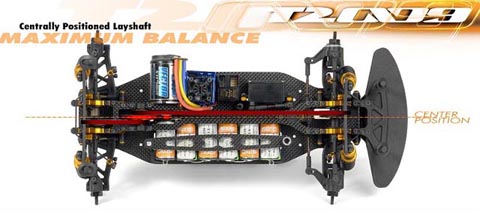
(click to enlarge) |
|
|
|
| One of the areas into which we invested a lot of time and effort was weight balance, more specifically the motor position. For quite a while the team tested different motor positions, but the feedback and my own experience were a bit mixed. For some particular tracks a more forward motor position is definitely better, but for some tracks the results were not quite so positive. Ultimately I decided to keep the T2â™009 with a well-proven configuration and keep the motor position changes as possible future options. This goes with what I mentioned previously; with current touring car designs at their maturity level it is very difficult to change or improve something that will work for everybody and everywhere. If you do not want to make the compromises you just need to continue testing and keep looking for better solutions. |
|
|
| Meanwhile we have to live for the present and for 2009 our team has created the new and optimized version of the worldâ™s best electric touring car, the T2â™009. I expect a bit of controversy due to the fact that for the first time we will offer a different color of the car. As mentioned before, performance is not in what you see but in what is inside. On the other hand, development is an ongoing process and maybe it is time for a color change as well. Sometimes you need to be open to trying new experiences, and since we are not going to jeopardize performance and handling I am open to new experiences and challenges as well. |
|
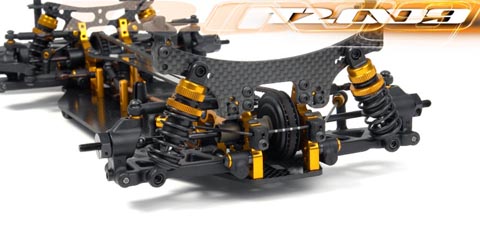
(click to enlarge) |
|
|
|
| My philosophy has always been to focus on design and performance, so when it comes to the color of the parts I prefer techy-looking stuff: black composite, black carbon fiber, brown HUDY Spring Steel™, and pure raw-colored aluminum. However, we constantly receive requests to make our cars in different colors. Using the worldâ™s strongest aluminum 7075 T6, we acknowledge that the properties that make it so strong also make it extremely difficult to color coat. If we would want to follow anodizing colors that are popular on the market we would have to change from super-strong 7075 T6 to softer aluminum which you can anodize any color. To be able to color coat the 7075 T6 we spent several months undergoing very demanding testing of different procedures, chemical mixes, and coating processes to develop our own technique for color coating. While extremely demanding, we gained a lot of experience and pioneered some new processes. There are several colors that we will never be able to consistently color using 7075 T6, but we did end up with a nice range of different colors to choose from. At the end the orange color was chosen as the favorite, it being our brand identifying color perfectly fitting the XRAY style. |
|
|
| The new T2â™009 is shipping these days and we have been packing our stuff for the last World Championship of the season. The team will be running with the T2â™009 and I am very excited already. I hope for a bit of good luck for our team, and wish again that customers will once again have great experiences with the new T2â™009. We invite you to share your experiences with us at our XRAY forum. |
|

|
Enjoy the ride and â�til the next time.
Dipl. Eng. Juraj Hudy
XRAY Chief Designer
|
| Column #26 - At the End of the Worlds |
|
| It is over. It is the middle of December and the 2008 racing season is definitely over. Dozens of international races, a dozen Euro and Worlds practices and warm-ups, 3 European Championships and 4 World Championships; that is how our statement of racing account would be this year. The last electric touring Worlds was one of the more anticipated races and one for which I had great expectations⦠and one that brought forth a whole range of emotions and feelings both positive and negative. |
|
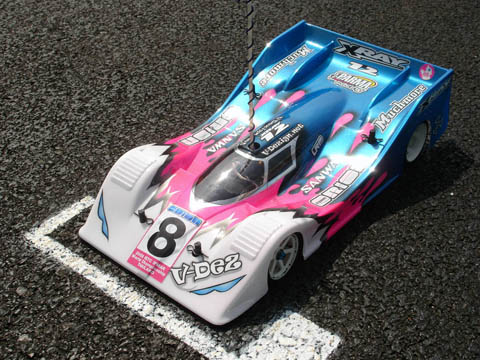
(click to enlarge) |
|
|
|
| At the last minute we decided to participate at the 1/12 Worlds which meant we needed to push development and production to the limit. The final pre-production car was tested at our factory tracks as well as at private sessions in Bangkok just before the Worlds. After the final design changes and final tuning of small details, we produced the team kits some of which were shipped directly to the drivers but due the time pressure some of the drivers got their first car at the Worlds. |
|
|
| Practice at the Worlds was looking very promising. When traction was high, Teemu (running on regular tires) was giving an utterly incredible & fastest debut of the XII with the rest of the team having very good lap times also. The car was fantastic with good balance, easy to run and handle. As the sun came up and traction decreased the game changed into one of car & driver to a different game of tires only. A few drivers who had very good asphalt-specific compounds separated themselves from the rest. Other teams had moderately-appropriate tire compounds and then there was our team with regular tires used for carpet racing. The performance gap looked like an abyss. Like with any high competition racing it is always the overall combo that separates the top from the rest and in this case we were definitely at a disadvantage. We have worked very hard for the last several months on development, testing and fine tuning of the car but we had no time left to test the dozens of different types of tires & special compounds on which other teams had worked for several months. In the qualifiers our lap times with regular tires were only good enough for the B-final. |
|
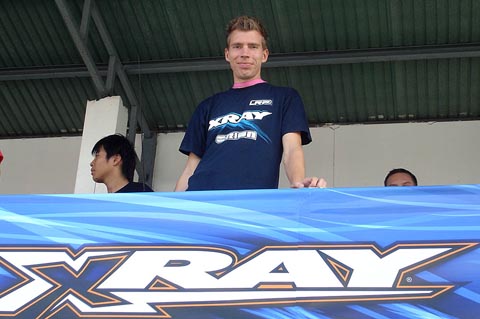
(click to enlarge) |
|
|
|
| After 4 (of 6) qualifiers, Teemuâ™s best result was 13 and 14th place. For the last two runs he was lucky enough to obtain one set of those special tires and suddenly with the same car & set-up he leapt forward into the 3rd and 4th qualifying position in the last two rounds, which bumped him into the A final. Such a huge difference just by swapping tires! On the day of finals the track was sugar-coated for higher traction and in the final practice run Teemu with his XII was the fastest with regular tires. Since he had no more of those special tires I just hoped the sun would not come out and the traction would remain consistent so he could battle for the podium. But you know whatâ™s coming. The sun came out, traction dropped significantly, and Teemu had no more chance with regular tires. So we had to settle with final position in the A main, which is still a great result and debut and I am very confident for a strong future. |
|
|
| Personally I was very satisfied with the car. With limited track time in the 1/12 category and such a high competition level I was able to qualify into the C final as the car was so easy to drive and handle that even if I did not have special tires and my old hands are not so quick anymore, I still was able to cruise around with no mistakes and get a good result. Being happy with all details of the car I gave the green light to the production team to immediately start mass production to get the kits ready for the winter season. |
|
|
| Without high expectation for our very first 1/12 Worlds, I was very much looking forward to the upcoming 1/10 Touring Worlds. Not only because we had great results and achievements at the previous warm-up and test sessions, but also because I knew that the whole team has worked very hard on the T2â™009 during the entire year with great results. Last-minute private testing before the Worlds both on the track and as well our factory track made me even more satisfied & comfortable and my expectations were very high. |
|
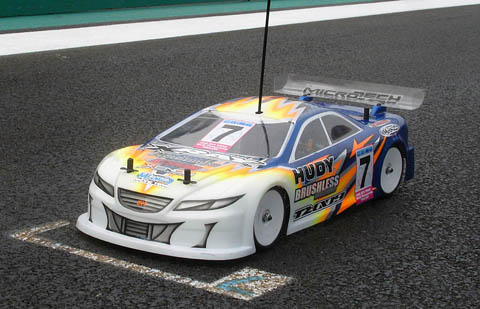
(click to enlarge) |
|
|
|
| My personal goal was to finish in the top 50 places and for the last few weeks I increased the intensity of testing and practicing as well. I worked and tested particularly around the weight balance of the car. The different motor position resulted in different handling characteristics. After extensive testing the rest of the team had decided for the standard, more rearward, motor position while for my personal racing style the more forward position suited me much better and I decided to keep this configuration. On the T2â™009 we made the chassis holes for both motor locations so with some easy conversion it will be possible to move the motor forward/backward as per everybodyâ™s own preference. In the kit the car comes with a standard rearward motor position and 34/20 pulleys which suits most of the drivers and is the best combination for stock motor racing. By swapping the 38T pulleys and exchanging the belts the motor will move forwards which is what best suits me, making the car smoother and less aggressive. Personally I felt that with this configuration the car was easier for me to drive and my consistent lap times proved that. This setting made the lap times a bit slower but what is more important was the extreme consistency at the end of the run and with a better final result. But again, this is all about personal preference as the rest of the team runs the standard kit. |
|
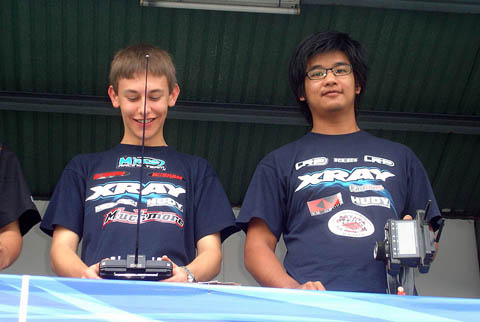
(click to enlarge) |
|
|
|
| The Worlds track layout was completely different from the practice layout where the corners were sharp and a lot of chicanes. Now the Worlds track had long and smooth corners so this was not the place for aggressiveness and sharp handling. To keep at the pace there was no space to push in the corners and a high need for a very smooth throttle finger. Despite the track layout being different, the T2â™009 worked well from the very first minute. In the qualifiers many drivers from the team had electronics, motor or set-up problems so the qualifiers were not going as expected. With the very low traction it was very important to find a set-up which would make the car roll through the corners with sufficient steering while still keeping a high cornering speed. From our team it was âśXRAY kidâť Eliott who quickly found a set-up that worked well for him and despite Eliott being new to the track and no previous practice, he was on pace with the worldâ™s best drivers. The other pleasant surprise of our team was another young XRAY driver â“ locally-known Meen â“ who was doing a great job as well as putting himself into the A main final by claiming a few 3rd place finishes in the qualifiers. The most interesting and admirable fact was that both Eliott and Meen received their new car from me at the Worlds, so both started the day by building and wrenching on the car and with few runs adapted the car by setting some of the fastest lap times and gaining a well-deserved place in the main final. |
|
|
| Where the young XRAY aces did their homework, it was the same place where the superstar top drivers failed. Teemu â“ who has been dominating at the Worldâ™s track at the TITC and practices â“ and Paul Lemieux (US champion with 3rd place title at the last World Championship) were definitely not satisfied with their qualifying results which put them only into a B-final position. Martin Hudy belonged to the all-star-frustrated group as after a previous great performance and results he was facing electronics, motor and set-up failures during all qualifiers and managed to qualify into the E final where I was qualified as well. For Martin his position was a huge disappointment to him; for me I was satisfied with my own qualifying position, as I was achieving my personal goal. So at the end it was only Eliott, Meen and myself who achieved a resolved target. |
|
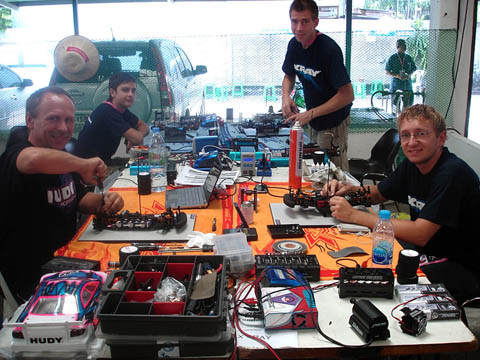
(click to enlarge) |
|
|
|
| The finals were very interesting to watch to see how individual cars handle throughout the day. In the first final when Rheinard collided with Hara it was Hirosaka who went into the lead followed by Volker and Eliott. Eliott pushed on Volker but he professionally did not make any mistake and both pulled away from Hara and caught on Hirosaka. In this first final it was Eliott who had the best-performing car and showcased top-class racing and his lap times were also the fastest. |
|
|
| The second final run started around noontime when the track was very hot. In this run it was my opinion that Hara had the best set-up for this hot track condition. Eliott, Rheinard and others were very equal and had similar lap times. |
|
|
| In between the second and last run the clouds made the track colder and as such the grip increased. Rheinard had the best set-up for this type of the track and he pushed Hara right after the start and then passed him. The rest of the drivers including Eliott, Volker, and Hara had the similar lap times. |
|
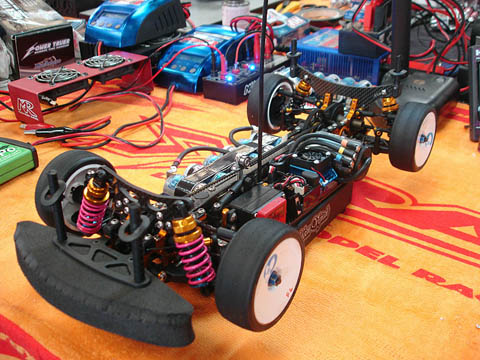
(click to enlarge) |
|
|
|
| It was very interesting to notice that in every final run a different car was performing best. Just a little different temperature was changing the performance of the cars. But note that we are only talking about time differences of 0.1 sec between the fastest lap times. Each car was handling differently in different conditions but the difference was so insignificant that only a few drivers in the world could feel the difference and get most out of it. This is where the World championship comes alive, in the battles for being the best of the best when the hundredths of a second start to count. It is the details that make the difference, details in set-up knowledge, experience, and of course it is also about luck. Just changing to a slightly wider offset or changing one shock spring rate between the final runs would be enough to decide between the first and last car. Just when the weather changed for a few moments it made the track different and different cars worked better. If the sun was shining the result could be different⦠if, if, if. All these IFs could bring about different situation and different result and different winner. The situation being as it was, the drivers being as they were, and the cars and set-up like they had made the results like they were supposed to be. This is what the World championship is about, getting the most out of everything. |
|
|
| For me the World Championship results for our team were both negative and positive. I anticipated a better result but then facing reality I realized that all the top drivers from the other teams are so equal in skills, performance and results that I knew that it would not be only the driver or only the car that would set the difference. The small differences separated the winners from the rest. At the end knowing that such young drivers like Eliott and Meen â“ one driver who did not test at the track and the other driver being just a driver who did not race much internationally, and who both got their cars just on the race â“ managed to face and in many cases beat the worldâ™s best full-time drivers, it makes me confident that our car is at an extremely high performance level and that we have a very good team. Sometimes this or that driver pulls the train, while next time it could be somebody else but the final result of the whole team is what matters. |
|
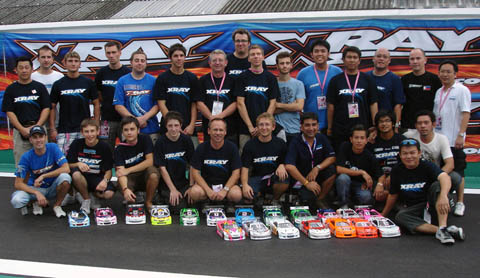
(click to enlarge) |
|
|
|
| As such I am very happy and proud of the whole team for the excellent and dedicated hard work not only during this World Championship but also during the whole year, and as such I want to thank everybody for their great work. I am very proud of all of you. Thanks for all other XRAY customers for making XRAY the most favorite brand at the Worlds. This is very important for me, knowing that customers appreciate all our hard work by choosing and using XRAY. Thank you to everybody for a thrilling and enjoyable 2008. I wish everybody even a better and more successful 2009. See you again next year on the tracks. |
|

|
Enjoy the ride and â�til the next time.
Dipl. Eng. Juraj Hudy
XRAY Chief Designer
|
|
|
|
|























